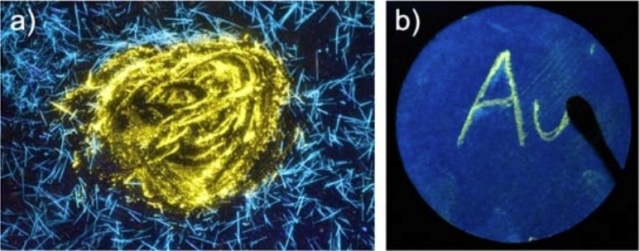Jul 15 2016
Scientists at Hokkaido University develop a series of luminescent compounds that change emission colors upon mechanical stimuli.
 Changes in colors emitted through mechanochromism a) When the blue crystal in emission was ground at the center, the color turned yellow. b) A round filter paper thinly coated with blue mechanochromic molecules in emission. The yellowish letters “Au” appeared after scratching the surface with a spatula.(Credit: Hokkaido University)
Changes in colors emitted through mechanochromism a) When the blue crystal in emission was ground at the center, the color turned yellow. b) A round filter paper thinly coated with blue mechanochromic molecules in emission. The yellowish letters “Au” appeared after scratching the surface with a spatula.(Credit: Hokkaido University)
In a phenomenon known as mechanochromism, certain solid and liquid crystalline materials change their photoluminescence properties upon mechanical stimulation, such as grinding, ball-milling and crushing. Although such compounds have attracted much attention with hopes of various applications, it has heretofore been thought difficult to synthesize mechanochromic compounds with desired emission properties and behaviors as each molecule emits different color.
A team of scientists at Hokkaido University in Japan synthesized 48 organic compounds containing gold atoms, or gold(I) isocyanide complexes—28 of which were found to be mechanochromic, emitting changing colors such as blue, green, yellow and orange upon stimulation.
With the aim of unraveling the mechanism behind the color changes, the researchers conducted detailed analyses of the crystal structures of almost all the molecules in the studied compounds: They found various formations of molecular arrangements, which, they concluded, is key to understanding the changes in their photoluminescence properties.
The finding could be applied to develop a sensor for detecting minute forces that occur in a several-nanometer segment in the cells—currently regarded as a difficult task. “If such a sensor is developed, it will contribute to identifying the mechanism for cellular movements and such,” said the research paper’s co-author Hajime Ito.
The research results were published in May in the Journal of the American Chemical Society and included in “JACS Spotlights.” The article was also selected as part of the “ACS Editors’ Choice” program.